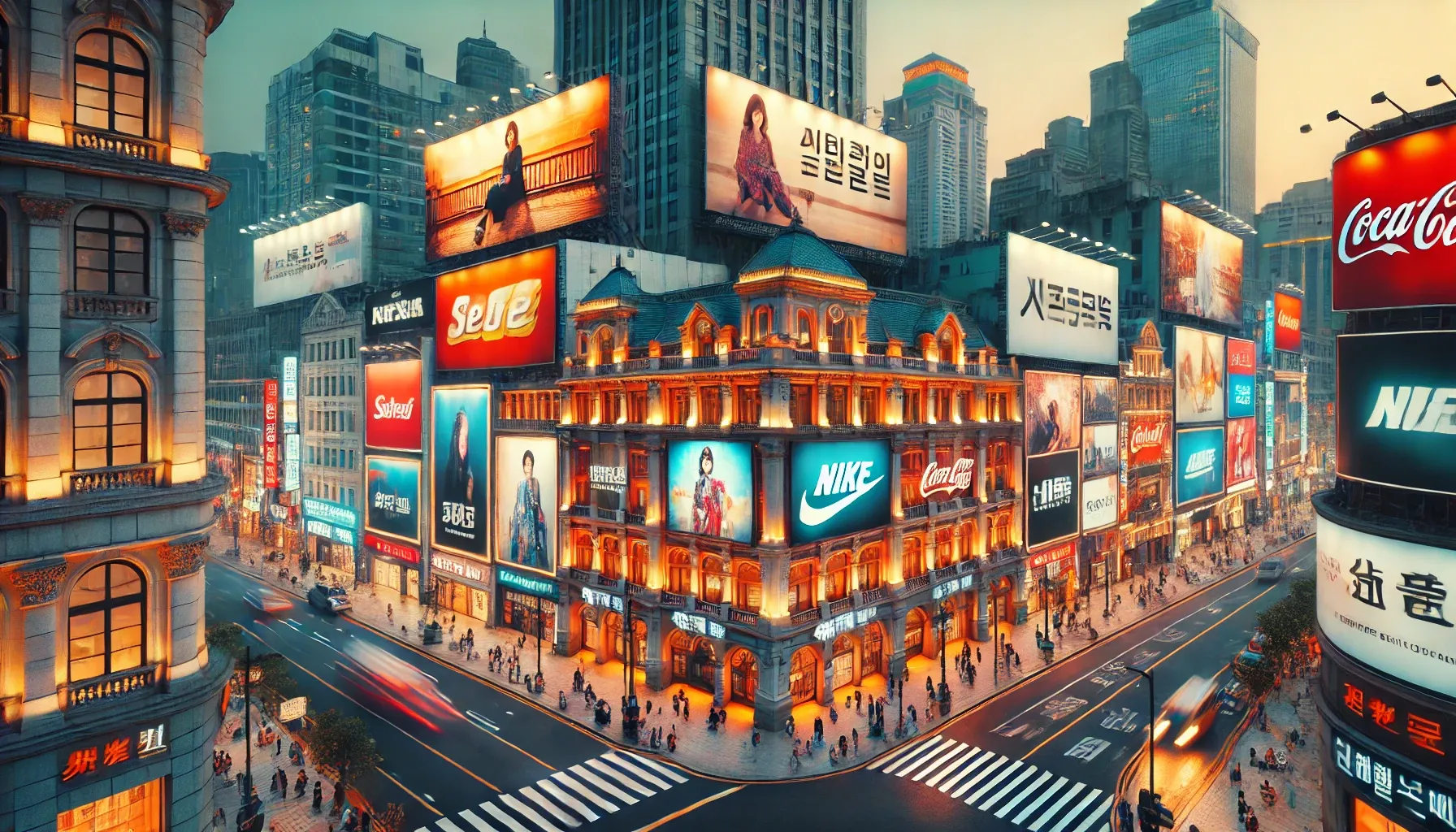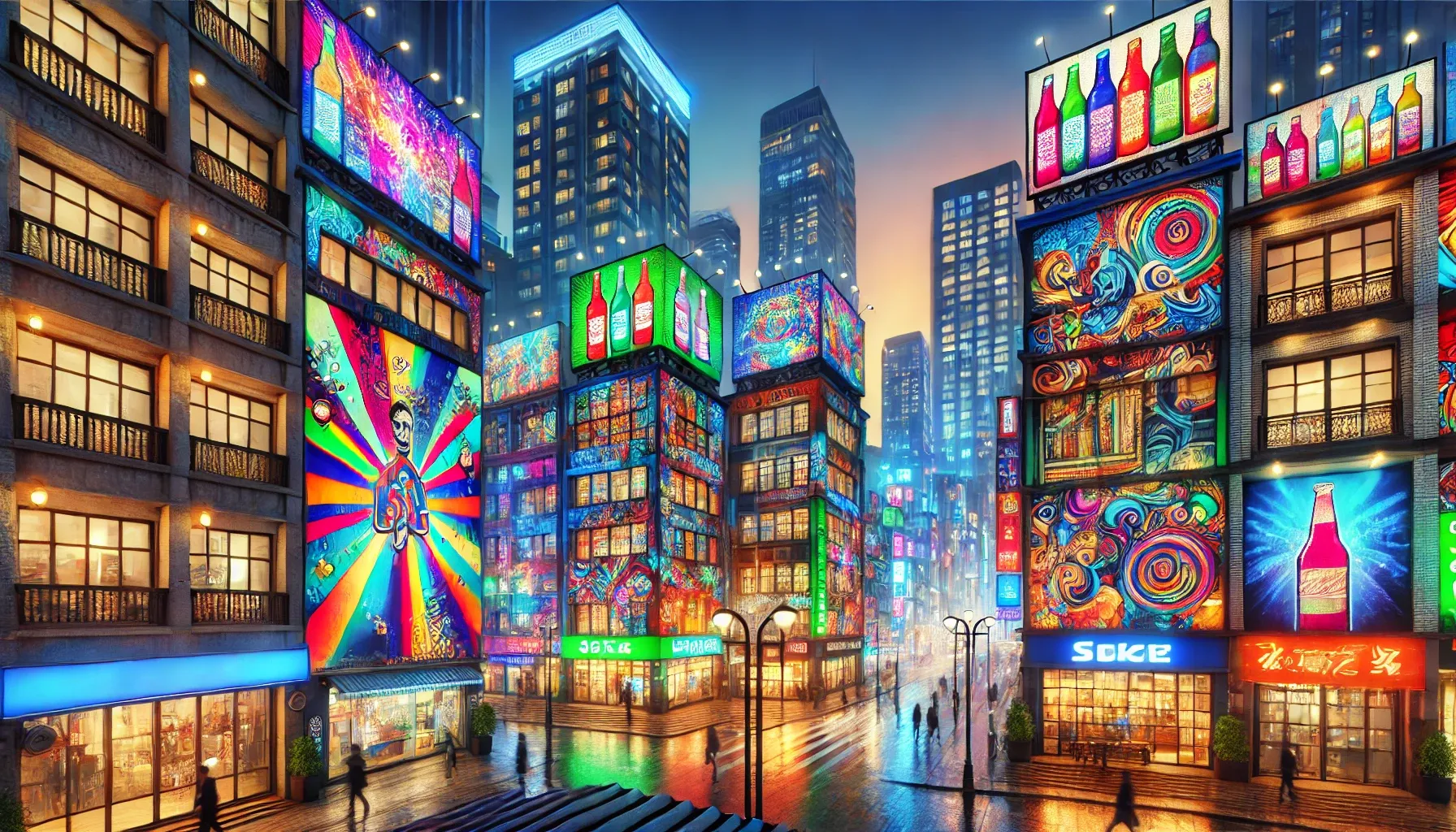Advertising on facades: how does it change the appearance of cities and help property owners?

- Billboards: How does advertising influence the city and its culture?
- How do false facades and media facades change the architectural appearance of modern buildings?
- How are new technologies changing architecture and visual solutions?
Billboard Advertising: Popularity and Opportunities
Billboards, also known as advertising boards, continue to gain popularity as an effective tool for promoting products and services of various companies. These structures, which can be located on vacant lots as well as on building walls, provide an additional source of income for their owners.
For example, in Amsterdam, the Sandberg Institute, part of the Dutch Design School, generates income from renting advertising space on its walls. In this case, a space of 29x35 cm is rented for just 19.99 euros. On the facades of this institute, you can see advertisements from world-renowned brands like Nike, Philips, Google, and Mercedes, as well as ads from unknown local businesses.
Financial opportunities for property owners
In the United States, commercial building owners in city centers have the opportunity to earn between $2,000 and $8,000 a month by placing advertising billboards. For example, in the business districts of London, owners can earn up to £25,000, while in major cities in France, such advertising can bring in around €80,000. In some cases, advertising becomes an essential tool for property owners, allowing them to meet their mortgage obligations.
The American company Adzookie offers an interesting approach — placing advertisements on the walls of houses, allowing owners to receive funds to pay off their loans for a period of three months to one year. In such cases, the facades of the buildings are painted in the colors of the advertisements, while the windows and doors remain unchanged. When the contract expires, the building returns to its original appearance.
Original advertising solutions
It is impossible not to mention the original advertising structures that incredibly effectively attract the audience's attention. For example, the advertising agency TM Advertising in Ohio implemented an impressive advertising campaign for the insurance company Nationwide Insurance. They installed three large billboards with striking images, such as paint cans and cars in a parking lot. This created a truly mesmerizing visual composition, and for this creative idea, the agency was awarded at the Cannes Lions International Festival of Creativity in 2008.
Critique of outdoor advertising
Nevertheless, billboard advertising sometimes becomes a subject of criticism. These structures can not only enrich urban culture but also distort the appearance of historical sites. For example, in Venice, there has been an increase in advertising materials on buildings, whereas just ten years ago, this was almost nonexistent.
The main reason lies in the poor condition of many buildings, and local authorities are facing a lack of funds for their restoration. Some historical monuments, such as the Doge's Palace, require enormous expenses — for example, 2.8 million euros for restoration, and advertising on the facades has become one of the funding options.
Public reaction and rules
However, such measures do not go without criticism. In 2010, prominent figures in the arts, including architect Norman Foster and leaders of institutions such as the British Museum and the New York Metropolitan Museum, sent an open letter to the Italian Minister of Culture requesting a ban on billboards, as they cause significant harm to the aesthetic appearance of Venice.
In a number of countries, there are strict regulations for outdoor advertising. For example, in the UK, prior approval from local authorities is required to install a billboard, which makes the placement process more controlled and systematic.
The need for advertising regulation
Society is gradually realizing the importance of finding a balance between commercial interests and the protection of historical heritage. The need to implement rules and standards in the field of outdoor advertising is becoming increasingly relevant in today's world, where the desire for creativity and individual expression must be combined with a responsible approach to the cultural environment.
Fines for illegal advertising placement
Placing advertising materials without obtaining the necessary permits can result in a fine of up to £2,500. In some U.S. states, such as Vermont, Maine, Alaska, and Hawaii, it is prohibited to install billboards.
The popularity of false facades
In recent years, there has been a growing popularity of false facades, which are becoming mandatory for use in a number of buildings, allowing them to conceal their true appearance. These structures often feature cladding panels attached to a sturdy metal framework that is carefully connected to the exterior walls of the buildings.
The history of false facades
False fronts are especially common in the United States. Their use began to gain popularity in the 19th century when building owners wanted to adorn their homes and commercial structures with beautiful facades to make them more appealing to visitors. False fronts are most often used:
- To mask outdated wooden structures that can no longer boast an attractive appearance.
- To hide the flaws of old buildings.
- During restorations and repairs.
For example, in 2003, during the restoration work on St. Paul's Cathedral in London, a decorative banner was installed that imitated the original facade of the building at full scale.
Architectural possibilities of false facades
False facades open new horizons in architectural styles, allowing for changes in building shapes and the addition of various complex elements.
29 September
9 October 2024
9 October 2024




As of today, there are many companies that specialize in designing media facades. They are most often installed during the construction of new buildings. One example is:
- The Wilkie Edge complex, created by Capitaland, is famous for its impressive screen that can display video streams in various resolutions.
- In 2008, the first eco-friendly building with a Greenpix facade was constructed in Beijing, which operates without carbon emissions.
- The media facade of the "Sicui" entertainment center, one of the largest in the world, was created by the architectural firm Simone Giostra & Partners, covering a total area of 2,200 square meters and featuring 2,292 LEDs.
This unique system can accumulate solar energy during the day and use it for lighting at night.
Modern media facade technologies
Another high-tech structure, the BIX media facade, is included in the Museum of Contemporary Art located in Graz, Austria. It can be configured to create three-dimensional graphics, vibrant lighting, and visual text messages. Unlike Greenpix, the BIX system is based on the use of fluorescent lamps.
Disadvantages of media facades
Nevertheless, it should be noted that media facades have their own drawbacks:
- Their effectiveness is only noticeable in conditions of darkness and twilight.
- This limits their use during the day.
The future of architecture
All these new trends and innovations show that architectural design of the future will increasingly integrate with the latest developments and modern requirements for the appearance of buildings.

In our time, one of the most pressing issues is the high cost of media facades. The average price for such a solution hovers around $20,000 per square meter, making them unaffordable for many companies. As a result, most of them turn to alternative visual technologies, with lighting and 3D projections being the most popular options.
Highlighting and its application
Lighting is usually used at events such as festivals, celebrations, and for decorating skyscrapers. In the evening, such buildings look especially impressive due to the original lighting.
Three-dimensional projections
As for projections, they represent an excellent opportunity to reduce costs on facade finishing while allowing for quick changes to the appearance of buildings without significant investments. They can be used to create visual representations of future structures, which is very useful during the planning and construction stages.
Advantages of design
Adapted projections that take into account the architectural features of buildings can highlight their elegance and grandeur. This option is also perfect for decorating historical monuments, for which there are strict regulations in most countries prohibiting their reconstruction. In recent years, there has been a sharp increase in interest in three-dimensional projections, which are used as a marketing tool to attract attention to products and services.
Global brands and innovations
Famous global companies, such asNissan,Samsung,DieselandUnileveractively integrates three-dimensional lighting technologies at their events, which allows for a more vibrant and impressive presentation of new products. For example, in 2009, the companySeepersI organized a mesmerizing three-dimensional installation at the film festival.Branchage Film, which took place on the island of Jersey.
Prices for projection services
The prices for implementing projections can vary significantly depending on the complexity of the technologies used. For example, a basic static projection may cost around 2,750 euros, while multi-scale light and music shows can range from 120,000 to 240,000 euros per night.
The emergence of QR codes
It is also worth mentioning the significant increase in the popularity of QR codes over the past ten years. These two-dimensional barcodes can be easily scanned using smartphone cameras and can be found on a variety of products, books, posters, and even tourist attractions.
Example from Tokyo
InTokyoFor example, a building was constructed with QR codes on the facade —N BuildingBy scanning such codes, users receive information about stores inside the building and can also read real-time reviews. This is becoming a great alternative to traditional billboards.
Initiatives in Dubai
InDubaiLocal authorities plan to digitize all buildings, including the tallest skyscraper in the world.Burj KhalifaThe use of QR codes will allow residents and tourists to access detailed information about buildings and quick access to services from local government institutions. This approach will also be useful for informing citizens about potential emergencies.
Digitized building in France
In addition, inFranceIn the near future, the first fully digitized building will emerge, which is being renovated by a Dutch architectural firm.MVRDVThese specialists are working on the restoration of an abandoned mustard factory, giving it modern features and incorporating digital technologies.
Conclusion
As a result, we can observe how new technologies and lighting solutions are actively being integrated into architecture, infusing it with new life and enhanced functionality.
Introduction
So, summarizing the discussion, we see that billboards and facades play a significant role in the modern urban landscape.
Positive aspects
On one hand, they are a source of income for building owners and can help fund the restoration of historical sites. In a highly competitive market, advertising becomes an essential tool for standing out among numerous other brands.
Negative aspects
However, on the other hand, the use of advertising in public spaces raises numerous questions and debates. The growing criticism from cultural figures and architects regarding how advertising affects the visual perception of historical buildings highlights the need for a comprehensive approach to regulating this area. The excessive placement of billboards can indeed detract from the aesthetics of cities, and the protection of cultural monuments should remain a priority.
False facades and media facades
False facades and media facades provide another aspect to this issue. They can not only mask the need for repairs or dilapidated buildings but also add new architectural elements, bringing variety to the urban landscape. While technological innovations like media facades open new horizons for visual advertising, their impact on the environment and residents also requires careful consideration.
The future of urban advertising
Ultimately, architectural solutions must balance the interests of business, aesthetic qualities, and cultural values to create a harmonious urban space. Considering all these aspects from the perspective of a responsible approach to advertising and the management of the urban environment can serve as a foundation for future projects focused on sustainable development.
Conclusion
I hope that in the future we will see a more intelligent and intentional use of advertising spaces that takes into account the needs of all participants in the urban ecosystem.
Comment
Popular Posts
29 September
357
9 October 2024
1485
9 October 2024
9935
Popular Offers

Subscribe to the newsletter from Hatamatata.com!
Subscribe to the newsletter from Hatamatata.com!
I agree to the processing of personal data and confidentiality rules of Hatamatata








